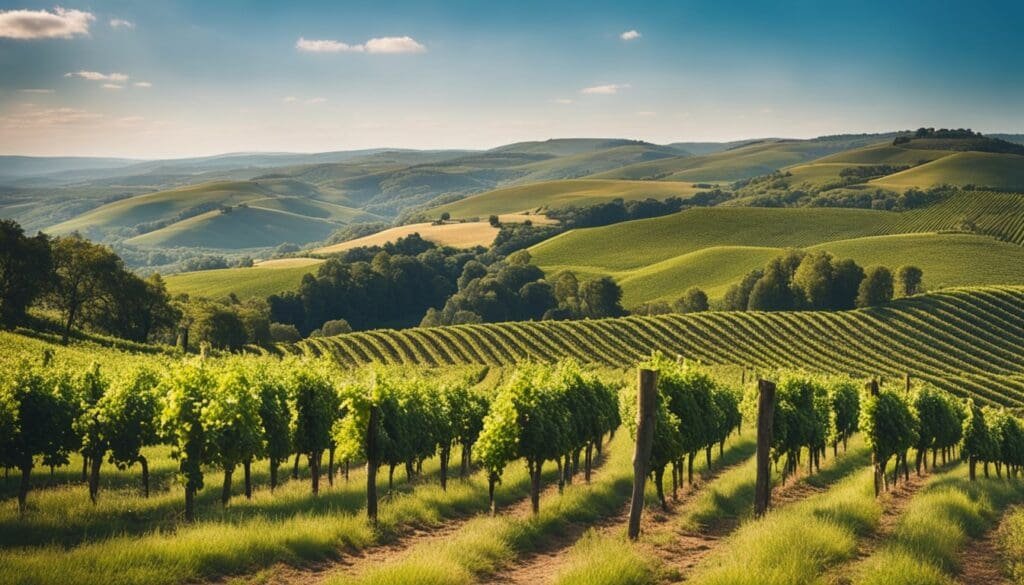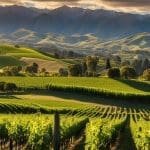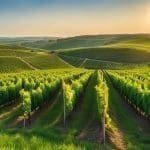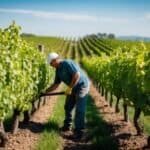This post may contain affiliate links. Please read my disclosure policy.
Overview of Eden Valley
Eden Valley, located in South Australia, is renowned for its cool climate and unique wine production. This picturesque region boasts rugged terrain, diverse elevations, and exquisite viticultural sites.
Location and Geography
Eden Valley is nestled in the Barossa zone of South Australia. It lies east of the famous Barossa Valley and is characterised by its higher elevation, ranging from 400 to 500 metres above sea level. The varied landscape includes gentle hills and steeper slopes, which influence the microclimates within the region. These microclimates play a crucial role in the success of its vineyards. The valley is also dotted with ancient red gums and native wildlife, adding to its scenic beauty and biodiversity. For more on Eden Valley‘s geography, visit the Barossa and Eden Valleys’ Geography.
Eden Valley Wine Region Distinction
Eden Valley is celebrated as one of Australia’s top cool-climate wine regions, making it distinct from its neighbour, the Barossa Valley. The area is renowned for producing premium wines, particularly Riesling and Shiraz. Riesling thrives in the southern end due to higher elevations, while Shiraz is more common in the north. The region’s cool climate allows for prolonged ripening periods, enhancing the flavour and acidity profile of the wines. Additionally, many vineyards here are boutique operations, contributing to the artisanal quality of the wine. To learn more about the winemaking in Eden Valley, you can explore the Eden Valley Wine Region.
The Climate of Eden Valley

Eden Valley, located in the Barossa zone of South Australia, features a cooler climate than the neighbouring Barossa Valley due to its higher altitude. This difference plays a significant role in how grapes are grown and the quality of wines produced in the region.
Effects on Viticulture
The altitude of Eden Valley has a major impact on its climate, affecting viticulture practices. Vineyards often sit at elevations between 380 and 632 metres above sea level. This high altitude ensures lower mean temperatures during the growing season, which is essential for cool-climate grape varieties like Riesling.
Cooler temperatures slow down grape ripening, allowing the grapes to develop more complex flavours and maintain natural acidity. Slopes and aspects are crucial in determining the mesoclimate of each vineyard, with north-easterly facing slopes benefiting from gentle morning sunlight while being shielded from harsh westerly winds. These conditions contribute to producing wines with delicate flavours and refined structures.
Comparison with the Barossa Valley
In contrast to Eden Valley, the Barossa Valley sits at lower altitudes and experiences higher temperatures. The average elevation in the Barossa Valley ranges from 200 to 400 metres, leading to a warmer climate that suits different grape varieties, such as Shiraz and Grenache.
Eden Valley is known for its rigorous conditions that produce elegant wines with higher acidity and more subtle aromas. On the other hand, the Barossa Valley tends to yield richer, fuller-bodied wines. The distinct climate of Eden Valley, with lower mean temperatures and specific mesoclimates provided by varied slopes and aspects, makes it one of Australia’s premier cool-climate wine regions.
Major Varietals and Winemaking

Eden Valley is renowned for producing high-quality wines from various grape varietals. This region has a rich mix of old and new winemaking traditions, showcasing its unique climate and terrain.
Signature Grapes of the Region
Eden Valley is celebrated for its Riesling, which thrives in the cool climate, allowing the grapes to develop crisp acidity and vibrant flavours. This varietal often features notes of lime, green apple, and floral undertones. Another star is Shiraz, known for its deep colour, rich fruit flavours, and hints of spice. Shiraz from Eden Valley is often more elegant compared to warmer regions.
Cabernet Sauvignon also holds a strong presence, producing wines with dark fruit characteristics and firm tannins. Chardonnay in Eden Valley benefits from the region’s cooler temperatures, resulting in wines with balanced acidity and complex flavours of citrus and stone fruit. Sauvignon Blanc and Merlot round out the region’s notable varietals, each bringing their unique profiles to the diverse offerings of Eden Valley wines.
Influential Winemakers and Estates
Eden Valley is home to several historic and influential wineries. Henschke stands out, particularly for its Hill of Grace Shiraz, which has gained international acclaim. Their commitment to sustainable and biodynamic practices sets a high standard in the region. Another key player is Yalumba, one of Australia’s oldest family-owned wineries, known for their innovative winemaking techniques and impressive portfolio of red and white wines.
Smaller boutique wineries also contribute significantly to the region’s reputation. They focus on quality over quantity, often enhancing the uniqueness of Eden Valley’s diverse terroir. These winemakers continue to experiment and evolve, maintaining a balance between tradition and innovation in the dynamic landscape of Australian wine.
Geology and Terroir

Understanding the relationship between the geology and terroir of Eden Valley is crucial for appreciating its unique wine qualities. This section looks at soil composition and terrain influences on the region’s vineyards.
Soil Composition
Eden Valley’s soil is diverse and plays a significant role in the terroir. The soils often feature a mix of ironstone gravels, quartz gravels, and rock fragments. These components contribute to the soil’s drainage and mineral content, impacting vineyard quality.
For instance, areas with more ironstone and quartz gravels tend to have superior drainage. This helps prevent waterlogging and encourages deeper root growth in vines. The presence of rock fragments also enhances the soil structure, providing aeration and promoting healthy vine growth. Additionally, the soil’s nutrient profile, including elements such as phosphorus (P), can vary significantly across sub-regions, like the lower P levels found in Eden Valley compared to the Eastern Ridge sub-region.
Terrain and Aspect Influences
The terrain and aspect of Eden Valley vineyards considerably influence the microclimate and grape growth. The valley features undulating hills and valleys, affecting sunlight exposure and temperature variations. Slope and aspect determine how much sun a vineyard receives, influencing grape ripening and flavour development.
Vineyards situated on slopes facing the optimal direction generally achieve better sunlight exposure. This is crucial for varieties like Shiraz, which benefits from specific microclimates. The differences in slope and aspect can also cause variations in soil moisture and temperature, creating diverse growing conditions even within small areas. For example, western-facing slopes may be less fertile, affecting vine vigour and grape quality differently than east-facing slopes.
Understanding these factors helps in selecting the best sites for different grape varieties, ensuring that each variety thrives in its ideal conditions within Eden Valley.
Cultural and Historical Context

Eden Valley has a rich cultural and historical backdrop, from early European settlers transforming the land to notable figures shaping its history.
Early Settlers and Development
The first European settlers arrived in Eden Valley around the 1830s. They came seeking fertile land for farming and sheep grazing. The Angas family played a significant role, establishing Hutton Vale Farm in 1843. Their contributions in agriculture and viticulture significantly shaped the local economy and landscape.
The First People also have a deep connection to the land, with their presence predating European settlement. Their culture and history remain integral to the area’s identity. Over time, settlers worked together to create a thriving community, developing farms, vineyards, and small towns.
Prominent Historical Figures
John Howard Angas stands out as a key figure in Eden Valley’s history. As a pioneering landholder, he established one of the first farms in the region. The Angas family helped in fostering agricultural development, with John Howard Angas becoming particularly notable for promoting viticulture.
Another significant individual is James Smith, known as the “Father of the Australian wine industry.” His efforts in vine cultivation have left a lasting impact, with wineries such as Yalumba becoming renowned. Their work in agriculture and winemaking have made long-lasting contributions to the cultural landscape of Eden Valley.
Their efforts have built a strong foundation for the community, with their legacies still evident in the thriving vineyards and farms that define the region today. This historical context provides valuable insight into the people who have shaped Eden Valley.
Tourism and Visitor Information
Eden Valley is a picturesque and tranquil region known for its premium cool climate wines and unique local attractions. The area offers plenty of opportunities for wine tasting and enjoying the beautiful natural scenery.
Wine Tasting and Cellar Doors
Eden Valley is renowned for its boutique wineries and cellar doors. You can visit Henschke Vineyards to taste exquisite wines made from some of the oldest vines in the region. Flaxman Wines offers a cosy tasting experience with hand-crafted wines that reflect the unique qualities of the Eden Valley terroir.
Another must-visit is Brockenchack Wines, which provides guided tours and tastings. If you’re looking for a more intimate experience, Fernfield Wines has a charming setting perfect for a relaxed picnic. Make sure to check out their newsletter for special events and new releases.
Local Attractions and Accommodations
In addition to wineries, Eden Valley offers several attractions and accommodations. The Eden Valley Hotel provides a comfortable stay with a touch of local history. Nearby, the farmers market is an excellent spot to sample local produce and handmade goods.
For those who enjoy nature, the Eden Valley Township has scenic walking trails and viewpoints. The area is also equipped with convenient amenities like picnic areas and carparks. Explore the charming streets and visit the local information centre for tips on must-see spots and events happening during your stay.
Frequently Asked Questions
Eden Valley is known for its unique wine varieties, climate, and rich cultural experiences. Here’s what you need to know about this remarkable wine region.
What are the notable varietals produced in the Eden Valley wine region?
Eden Valley is famous for its Riesling, which features prominently in its wine offerings. Besides Riesling, the region is noted for Shiraz, Chardonnay, and Merlot. These wines are known for their distinct flavours and high quality due to the region’s unique growing conditions.
Can you provide a guide to the cellar doors in Eden Valley?
Eden Valley boasts several notable cellar doors like the Henschke, which offers tastings of their renowned wines. Other top cellar doors include Eden Valley Vineyard, where you can sample their organic and biodynamic wines. Each cellar door provides a personalised wine experience and the opportunity to learn directly from the winemakers.
What climatic conditions influence wine production in the Eden Valley?
Eden Valley’s climate is cooler compared to neighbouring regions. It experiences distinct seasonal variations with cold, wet winters and warm, dry summers. These conditions are ideal for growing premium grape varieties and significantly influence the flavours and quality of the wines produced.
What culinary experiences complement Eden Valley wines?
Eden Valley wines, especially its Rieslings and Shiraz, pair well with various cuisines. You can enjoy Riesling with seafood and light salads, while Shiraz complements hearty dishes like roasted meats and rich stews. Local restaurants often use fresh, regional produce to create dishes that enhance the wine-tasting experience.
How does the terroir of Eden Valley shape its Riesling’s taste profile?
The terroir of Eden Valley, with its well-drained soils and varied topography, contributes to the distinctive taste of its Riesling. The presence of sandy loam over clay and gravel enhances the aromatic profile of the grapes, resulting in Rieslings that are crisp, vibrant, and highly aromatic with a refined acidity.
What scenic and cultural attractions can be found in the Eden Valley area?
Eden Valley offers a range of scenic and cultural attractions. Visitors can explore the beautiful landscapes, including rolling hills and vineyards. The area is home to local markets, historical sites, and artisanal shops that reflect the rich cultural heritage of the region. For a more detailed guide, visit this page.
User Review
( votes)Sip smarter, subscribe now!
Subscribe for gourmet tips, event updates, travel ideas, and a free e-book on Food Pairings. Start your journey to culinary and travel excellence!













